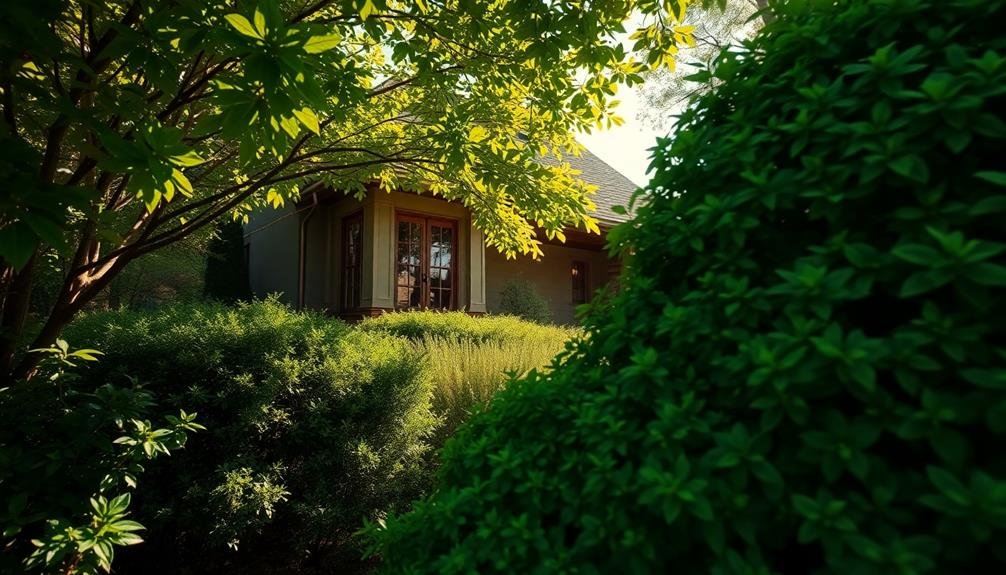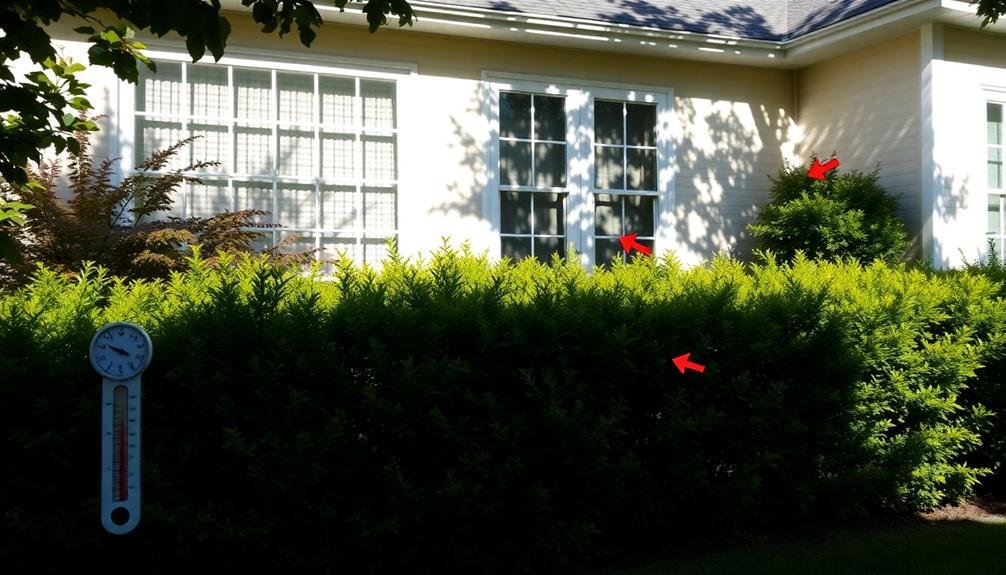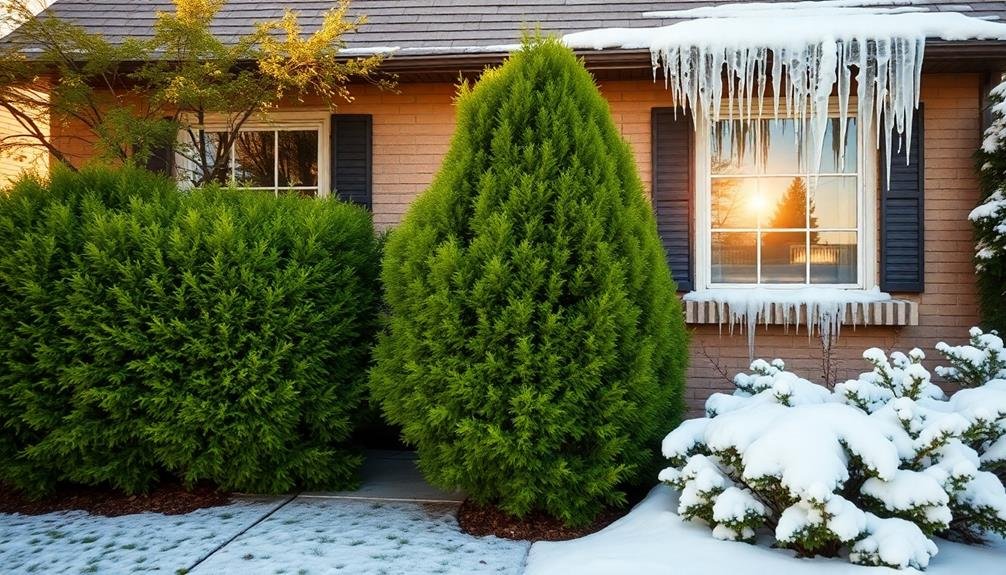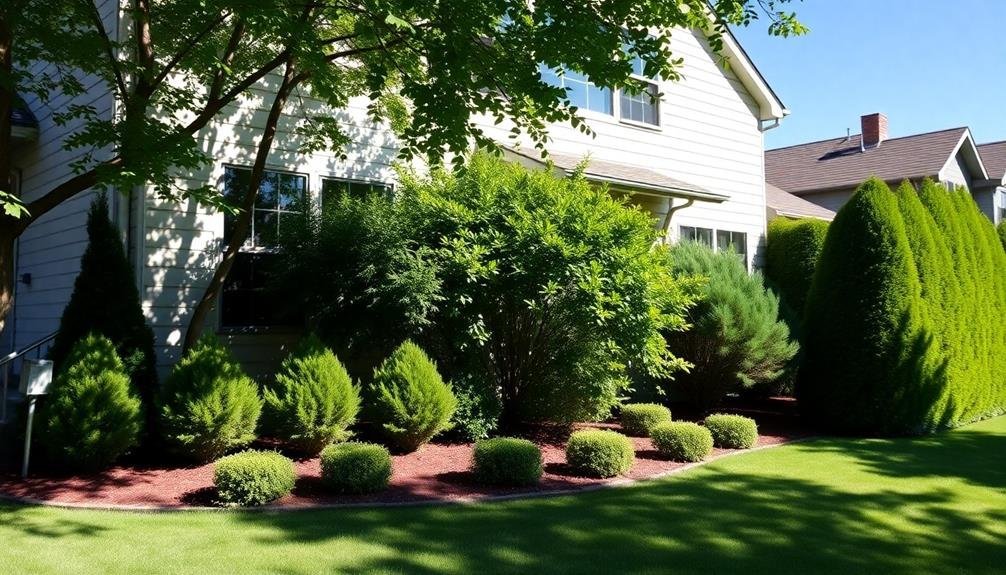Planting shrubs around your home can greatly boost its energy efficiency and cut utility costs. These natural insulators create a protective barrier, regulating indoor temperatures and reducing energy consumption by up to 25%. They act as windbreaks, minimizing heat loss in winter and hot air infiltration in summer. Strategically placed shrubs provide shade, lowering cooling needs, while deciduous varieties allow winter sun to warm your home. They also protect foundations, absorb rainwater, and improve air quality. With proper placement and maintenance, shrubs offer year-round benefits that extend beyond energy savings, enhancing your home's value and environmental impact.
Natural Insulation Benefits

Shrubs act as nature's insulation, creating a protective barrier around your home. They help regulate temperature by blocking cold winds in winter and providing shade in summer. When strategically planted, shrubs can reduce your home's energy consumption by up to 25%. They're particularly effective when placed on the north and northwest sides of your house to shield against harsh winter winds.
In summer, shrubs planted near windows and walls absorb sunlight and heat, keeping your home cooler. This natural cooling effect can considerably reduce your air conditioning needs. Evergreen shrubs are especially useful, as they provide year-round insulation benefits.
Dense shrubs also create a layer of still air between the plant and your home's exterior, further enhancing insulation. This air pocket acts as an additional buffer against temperature fluctuations. By reducing heat gain in summer and heat loss in winter, shrubs help maintain a more consistent indoor temperature, easing the workload on your HVAC system.
Moreover, shrubs can protect your home's foundation from extreme temperature changes, potentially preventing structural issues over time. They also absorb rainwater, reducing soil erosion and moisture buildup around your home's perimeter.
Wind Barrier Effectiveness
A natural windbreak, strategically planted shrubs can greatly reduce wind speed around your home. This reduction in wind velocity helps minimize heat loss during cold months and prevents hot air infiltration in summer. You'll notice a significant decrease in your heating and cooling costs as a result.
When planning your shrub windbreak, consider the prevailing wind direction in your area. Plant dense, evergreen shrubs on the windward side of your house, typically the north and northwest sides. Create multiple rows of shrubs for maximum effectiveness, with taller varieties closer to your home and shorter ones on the outer edges.
| Windbreak Type | Wind Speed Reduction | Energy Savings |
|---|---|---|
| Single Row | 10-20% | 5-10% |
| Double Row | 20-40% | 10-20% |
| Triple Row | 40-60% | 20-30% |
The table above illustrates the potential wind speed reduction and corresponding energy savings based on different windbreak configurations. By implementing a well-designed shrub windbreak, you're not only enhancing your home's energy efficiency but also creating a more comfortable outdoor environment. Remember to maintain your shrubs regularly to guarantee they continue providing peak wind protection year-round.
Shade and Temperature Control

Strategic placement of shrubs around your home can provide a natural cooling effect, reducing indoor temperatures during hot months.
You'll benefit from lower air conditioning costs as these plants absorb sunlight and create shade.
To maximize energy efficiency, position shrubs on the south and west sides of your house, where they'll block the most intense sunlight.
Natural Cooling Effect
Through strategic placement of shrubs around your home, you'll create a natural cooling effect that can considerably reduce your energy costs. Shrubs act as natural air conditioners, releasing moisture through a process called transpiration. This moisture evaporates, cooling the surrounding air and lowering the ambient temperature.
Plant deciduous shrubs on the south and west sides of your house to maximize their cooling potential. During hot summer months, these shrubs will provide shade and release cooling moisture. In winter, they'll lose their leaves, allowing sunlight to warm your home naturally.
Consider creating a "living wall" of shrubs near windows and walls that receive direct sunlight. This barrier will block heat and reduce the amount of solar radiation absorbed by your home's exterior. Additionally, shrubs can direct cool breezes towards your home while deflecting hot air.
Choose native shrubs adapted to your local climate for best results. They'll require less maintenance and be more effective at creating a natural cooling effect.
Reduced Air Conditioning Costs
Planting shrubs strategically around your home can cut down on your air conditioning costs considerably. By creating shade and reducing ambient temperatures, shrubs act as natural insulators, minimizing the heat that enters your home. This means your air conditioning system won't have to work as hard to maintain a comfortable indoor temperature.
To maximize the cost-saving benefits of shrubs for air conditioning:
- Plant deciduous shrubs on the south and west sides of your house to block summer sun while allowing winter warmth.
- Choose dense, evergreen shrubs for year-round insulation on the north side.
- Position shrubs near windows and walls to shade these heat-absorbing surfaces.
- Create a "green corridor" effect by planting multiple shrubs in a row for enhanced cooling.
You'll notice the difference in your energy bills, especially during peak summer months. As shrubs mature, their cooling effect increases, leading to even greater savings over time.
Optimal Shrub Placement
Maximizing the energy-saving potential of shrubs hinges on their ideal placement around your home. To achieve best shade and temperature control, focus on planting shrubs on the south and west sides of your house. These areas receive the most intense sunlight during the hottest parts of the day, making them prime locations for energy-saving vegetation.
For the south-facing side, plant deciduous shrubs that will provide shade in summer but allow sunlight to warm your home in winter. On the west side, use a mix of evergreen and deciduous shrubs to create a year-round barrier against afternoon sun and hot winds.
Plant taller shrubs closer to the house for maximum shading effect, but keep them at least 3 feet away from the foundation to prevent moisture issues.
Don't forget about windows – strategically placed shrubs can shade them without blocking views. For east-facing windows, consider lower-growing shrubs that won't obstruct morning light.
When planting near air conditioning units, leave enough space for proper airflow while still providing shade. By carefully positioning your shrubs, you'll create a natural cooling system that greatly reduces your home's energy consumption.
Reduced HVAC Energy Consumption
Strategically placed shrubs can considerably reduce your home's HVAC energy consumption. By creating a natural barrier against external elements, shrubs help regulate your home's temperature, reducing the workload on your heating and cooling systems. This translates to lower energy bills and a smaller carbon footprint.
When you plant shrubs around your home, you're fundamentally creating a microclimate that buffers against extreme temperatures. In summer, shrubs provide shade and evaporative cooling, while in winter, they act as windbreaks, reducing heat loss. This natural insulation can lead to significant energy savings throughout the year.
To maximize HVAC energy savings with shrubs:
- Plant deciduous shrubs on the south and west sides of your home for summer shade.
- Use evergreen shrubs as windbreaks on the north and northwest sides.
- Leave a gap between shrubs and walls to prevent moisture buildup.
- Choose native species that are well-adapted to your local climate.
Seasonal Considerations for Planting

When planning your energy-efficient landscape, you'll need to take into account the ideal seasons for planting and maintaining shrubs.
In spring, you can take advantage of mild temperatures and ample rainfall to establish new plantings, while summer requires careful watering and mulching strategies to protect your shrubs from heat stress.
As fall approaches, you'll want to focus on preparing your shrubs for the colder months ahead, including pruning and fertilizing to promote healthy growth in the following year.
Spring Planting Advantages
Spring offers ideal conditions for planting energy-efficient shrubs around your home. The moderate temperatures and increased rainfall create an environment where newly planted shrubs can establish strong root systems before the heat of summer arrives.
You'll find that spring-planted shrubs require less watering and maintenance compared to those planted in other seasons.
Take advantage of spring's benefits for your energy-efficient landscaping:
- Longer growing season: Spring-planted shrubs have more time to grow and develop before winter dormancy.
- Better soil conditions: Spring's moist soil is easier to work with and promotes healthy root growth.
- Wider plant selection: Nurseries often stock a greater variety of shrubs in spring.
- Energy savings start sooner: Early planting allows shrubs to begin providing shade and wind protection earlier.
Summer Care Strategies
Summer's scorching temperatures call for extra attention to your newly planted energy-efficient shrubs. To guarantee their survival and maximize their energy-saving potential, you'll need to implement specific care strategies.
First, focus on watering. During hot months, water deeply and less frequently to encourage deep root growth. This helps shrubs become more drought-resistant and efficient at shading your home. Mulch around the base of your shrubs to retain moisture and regulate soil temperature.
Monitor for pests and diseases, which can thrive in summer conditions. Regularly inspect leaves and stems, treating issues promptly to maintain the shrubs' health and effectiveness as energy-savers.
Here's a quick reference guide for summer shrub care:
| Task | Frequency | Tips |
|---|---|---|
| Watering | 2-3 times/week | Water deeply, early morning or evening |
| Mulching | Monthly | Maintain 2-3 inch layer, avoid stem contact |
| Pest inspection | Weekly | Look for discoloration, holes, or unusual growth |
Fall Preparation Techniques
As summer fades, it's time to shift your focus to fall preparation techniques for your energy-efficient shrubs. These steps will guarantee your plants remain healthy and continue to provide insulation benefits throughout the colder months.
Start by evaluating your shrubs' overall health and trimming any dead or diseased branches. This promotes air circulation and prevents potential issues during winter.
Next, adjust your watering schedule. As temperatures cool, your shrubs will require less frequent watering, but make sure the soil remains consistently moist until the ground freezes.
Apply a layer of mulch around the base of your shrubs to retain moisture and regulate soil temperature.
To optimize your shrubs' energy-saving potential this fall:
- Plant new shrubs early in the season to allow root establishment before winter
- Choose cold-hardy varieties suitable for your climate zone
- Group shrubs with similar water and sunlight needs together
- Consider adding evergreen shrubs for year-round insulation
Lastly, protect young or vulnerable shrubs from frost damage by covering them with burlap or specialized plant covers on particularly cold nights.
Best Shrub Species for Insulation
When it comes to choosing shrubs for energy efficiency, certain species excel at providing insulation for your home. Evergreen shrubs are particularly effective, as they maintain their foliage year-round.
Consider planting dense, low-growing varieties like boxwood (Buxus) or yew (Taxus) along your home's foundation. These create a barrier against cold winds and help maintain a stable temperature around your house.
For taller windbreaks, opt for arborvitae (Thuja) or holly (Ilex). These can shield your home from harsh winter winds and reduce heat loss.
In warmer climates, consider laurel (Prunus laurocerasus) or viburnum for their thick, broad leaves that provide excellent insulation.
Don't overlook deciduous shrubs, either. While they lose leaves in winter, they can still offer benefits.
Plant oakleaf hydrangea (Hydrangea quercifolia) or witch hazel (Hamamelis) on the south and west sides of your home. In summer, they'll shade your walls and windows, reducing cooling costs. In winter, they'll allow sunlight to warm your home naturally.
Remember to plant shrubs at least 2-3 feet from your home's foundation to prevent moisture issues and allow for proper air circulation.
Proper Placement Around the Home

Strategic placement of shrubs around your home is essential for maximizing energy efficiency.
You'll want to focus on areas where they can provide the most benefit regarding insulation and temperature regulation. Consider planting deciduous shrubs on the south and west sides of your house to block summer sun while allowing winter sunlight to warm your home.
For ideal energy savings, follow these placement guidelines:
- Plant tall shrubs on the north side to act as a windbreak, reducing heat loss in winter.
- Use dense evergreens on the northwest side to shield against cold winter winds.
- Place shrubs near windows to provide shade and reduce cooling costs in summer.
- Keep shrubs at least 3 feet away from your home's foundation to prevent moisture issues.
Remember to account for the mature size of your chosen shrubs when planting.
You don't want them to obstruct windows or interfere with utilities as they grow.
Maintenance and Pruning Tips
To keep your energy-efficient shrubs in top form, you'll need to establish a seasonal pruning schedule.
You'll want to invest in quality pruning tools, such as sharp bypass pruners and loppers, to guarantee clean cuts and prevent damage to the plants.
Shape your shrubs strategically to maintain their energy-saving benefits, focusing on dense growth patterns that maximize shade in summer and wind protection in winter.
Seasonal Pruning Schedule
A well-planned pruning schedule is crucial for maintaining healthy, energy-efficient shrubs throughout the year. By following a seasonal approach, you'll guarantee your shrubs provide ideal shading and insulation for your home.
In spring, focus on removing dead or damaged branches from winter. This allows new growth to flourish and helps shape the shrub for maximum energy efficiency.
Summer pruning should be minimal, primarily to control excessive growth that might interfere with your home's ventilation or solar exposure.
Fall is the perfect time for major pruning, as most shrubs are entering dormancy. You'll want to:
- Thin out dense growth to improve air circulation
- Remove crossing or rubbing branches
- Cut back overgrown shrubs to maintain desired size
- Shape evergreens to enhance their insulating properties
Winter pruning should be limited to removing storm-damaged branches or performing light shaping on deciduous shrubs.
Remember, each shrub species has specific pruning requirements, so research your particular plants or consult a local expert for tailored advice.
Tools for Proper Maintenance
For proper maintenance of your energy-efficient shrubs, you'll need the right tools at your disposal. Start with a pair of high-quality pruning shears for small branches and precise cuts. Invest in loppers for thicker branches up to 2 inches in diameter. For larger limbs, a pruning saw will be essential. Don't forget a sturdy pair of gardening gloves to protect your hands.
To maintain soil health, you'll want a garden fork and a trowel for planting and fertilizing. A rake helps clear debris and spread mulch evenly. For watering, choose a hose with adjustable nozzle settings or install a drip irrigation system for effective water distribution.
Keep your tools clean and sharp to prevent disease spread and guarantee clean cuts. After each use, wipe blades with rubbing alcohol and oil moving parts to prevent rust. Sharpen blades regularly with a whetstone or file. Store tools in a dry place to extend their lifespan.
Consider investing in a soil moisture meter and pH tester to monitor your shrubs' growing conditions. These tools will help you maintain ideal soil health and water efficiency, maximizing your shrubs' energy-saving potential.
Shaping for Optimal Efficiency
Shaped correctly, shrubs can maximize their energy-saving potential. Proper pruning and shaping techniques help maintain the shrubs' effectiveness as windbreaks and shade providers. You'll want to focus on creating a dense, full shape that blocks wind and sun effectively.
When shaping your shrubs for ideal energy efficiency, follow these key tips:
- Prune in late winter or early spring before new growth begins.
- Remove dead, damaged, or crossing branches first.
- Thin out dense areas to promote air circulation and prevent disease.
- Maintain the natural shape of the shrub while guiding its growth.
Remember to use clean, sharp tools to make clean cuts that heal quickly. Don't remove more than one-third of the shrub's growth in a single season, as this can stress the plant.
For deciduous shrubs, prune to create a fuller shape that'll provide better shade in summer. For evergreens used as windbreaks, focus on maintaining a dense, triangular shape from ground to top.
Regular maintenance is essential. You'll need to shape your shrubs annually or semi-annually, depending on their growth rate and your climate.
Cost Savings Over Time

Calculating the long-term financial benefits of planting shrubs for energy efficiency can be eye-opening. When you invest in strategically placed shrubs, you're setting yourself up for substantial savings on your energy bills over time.
These natural barriers can reduce your heating and cooling costs by up to 25% annually, depending on your climate and property layout.
Consider the math: If your average monthly energy bill is $200, you could save up to $600 per year. Over a decade, that's $6,000 in potential savings. The initial cost of purchasing and planting shrubs is typically recouped within 3-5 years, making it a smart financial decision.
Don't forget about the added value to your property. Well-maintained landscaping can increase your home's value by up to 10%. This means your energy-efficient shrubs aren't just saving you money; they're also boosting your home's worth.
As shrubs mature, their efficiency increases. You'll see greater savings in years 5-10 compared to the initial years.
Environmental Impact of Shrub Insulation
The environmental benefits of shrub insulation extend far beyond your property lines. By planting shrubs strategically around your home, you're contributing to a healthier ecosystem and reducing your carbon footprint.
Shrubs act as natural air filters, absorbing pollutants and releasing oxygen, improving air quality in your neighborhood.
You'll also be creating habitats for local wildlife, supporting biodiversity in your area. Birds, insects, and small mammals will find shelter and food sources in your shrubs, fostering a more balanced ecosystem.
Here's how shrub insulation positively impacts the environment:
- Reduced energy consumption: Less reliance on heating and cooling systems means lower greenhouse gas emissions
- Carbon sequestration: Shrubs absorb carbon dioxide, helping to mitigate climate change
- Soil conservation: Root systems prevent erosion and improve soil health
- Water management: Shrubs help regulate water flow, reducing runoff and flooding risks
Frequently Asked Questions
How Long Does It Take for Newly Planted Shrubs to Become Effective Insulators?
It'll take about 3-5 years for your newly planted shrubs to become effective insulators. During this time, they'll grow denser and taller, creating a better barrier against wind and sun. Regular maintenance will help speed up the process.
Can Shrubs Help Reduce Noise Pollution Around the Home?
Yes, shrubs can effectively reduce noise pollution around your home. They'll absorb sound waves, creating a natural barrier. You'll notice a significant difference in outdoor noise levels, especially if you plant dense, evergreen varieties near noise sources.
Are There Any Potential Drawbacks to Using Shrubs for Home Insulation?
While shrubs can insulate your home, they've got drawbacks. You'll need regular maintenance, and overgrown plants might damage your house. They can also attract pests and block sunlight. Consider these factors before relying on shrubs for insulation.
How Do Shrubs Compare to Artificial Barriers for Energy Efficiency?
You'll find shrubs offer natural beauty and seasonal changes that artificial barriers can't match. While man-made options may provide consistent insulation, shrubs can be more cost-effective and environmentally friendly in the long run.
Can Shrubs Interfere With Home Security Systems or Surveillance Cameras?
Yes, shrubs can interfere with your home security systems and cameras. They might block views, trigger motion sensors, or provide cover for intruders. You'll need to carefully plan their placement and maintain them regularly to avoid these issues.
In Summary
You've learned how shrubs can be a natural, eco-friendly way to boost your home's energy efficiency. By planting these green allies strategically, you'll create insulation, block winds, and provide shade. You'll reduce your HVAC costs and environmental impact while enhancing your property's beauty. Remember to contemplate seasonal changes, proper placement, and maintenance needs. With time, you'll see significant cost savings and enjoy a more comfortable, energy-efficient home. It's a win-win for you and the environment.





Leave a Reply